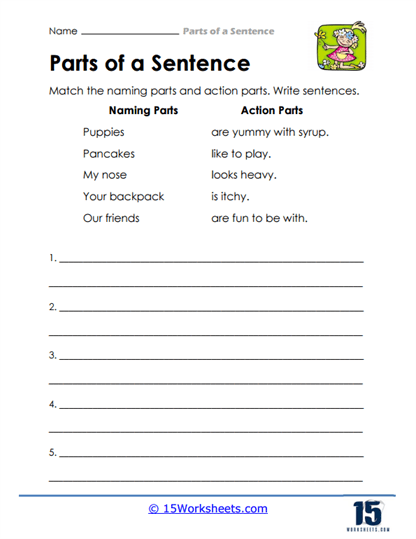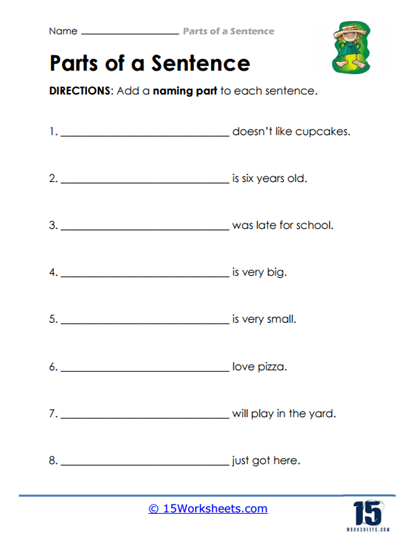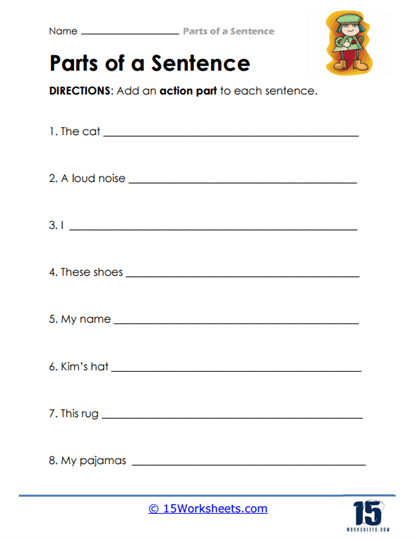Parts of a Sentence Worksheets
About These 15 Worksheets
Sentences may look simple, but they’re built like little machines-each one needs a naming part (the subject) and an action part (the predicate) to run smoothly. Without both, the sentence just sputters out or doesn’t even start! These worksheets break down that big idea into playful, bite-sized activities that kids can actually enjoy. From matching games to sentence puzzles, the collection keeps grammar practice from ever feeling dry or repetitive.
What makes these pages shine is the balance between structure and creativity. One worksheet has kids fixing scrambled sentences, another has them making their own from pictures, and others drill down on spotting verbs or subjects. By cycling through these activities, students move from “I think I kinda get this” to “I can build and split sentences with no problem.” The variety ensures every type of learner-visual, hands-on, or analytical-gets a way in.
Beyond the classroom, this practice helps students become stronger readers and writers. When kids can spot subjects and verbs instantly, they naturally understand meaning faster and write more clearly. That means smoother storytelling, stronger essays, and fewer “what does this sentence even mean?” moments. Grammar stops being a mysterious rulebook and starts feeling like a set of building blocks they can actually play with.
Have a Look Inside Each Worksheet
Partial Matchups
Students get to match naming parts (like “The cat”) with action parts (“runs fast”). This turns grammar into a simple pairing puzzle that feels like a game. By connecting subjects and predicates in this way, kids clearly see how the two pieces must work together. It’s a fun starter activity for learning how sentences are built.
Part Pointers
Here, students highlight which words are naming or action parts in sentences. It’s like turning on a spotlight to show where the subject and predicate are hiding. This activity strengthens their ability to pick apart sentences quickly. With enough practice, they’ll start spotting these parts in their everyday reading too.
Subject Matchers
Learners are given subjects and asked to match them with the right predicates. It feels like a quick “sentence speed-dating” activity-where each subject finds its perfect action partner. The exercise makes it clear that a subject alone can’t make sense without its other half. This playful practice cements the importance of sentence balance.
Part Pickers
Students look at given sentences and choose which part is the naming part and which is the action part. It’s a focused activity that forces them to think carefully about what’s doing the action and what’s being described. This helps build analytical skills in grammar without feeling too overwhelming. The worksheet is a nice mix of reading and decision-making practice.
Thought Breakers
Sentences are split into fragments, and students are asked to separate them into naming and action parts again. It feels like taking a scrambled puzzle and putting it back together. This interactive approach builds problem-solving skills while reinforcing grammar rules. Kids enjoy the “fixing” element, which makes practice less repetitive.
Subject Search
In this worksheet, learners search for the subject in each sentence. It’s like a grammar detective game where they shine a light on the “who” or “what.” By practicing this skill over and over, students become confident in identifying subjects quickly. It’s a must-have step before more advanced sentence building.
Statement Splitters
Students take full sentences and break them into naming and action parts. This is a great “reverse-engineering” approach that shows them how sentences are put together. They’ll notice that every complete thought really is two sides of the same coin. The clarity of this exercise makes it perfect for beginners.
Verb Spotter
Here, the challenge is to find the verb in each sentence. Since verbs are the heart of the action part, this helps students focus on the engine of the sentence. The activity trains them to zero in on action words quickly. It’s a simple but powerful way to sharpen grammar instincts.
Subject Selector
Students choose the correct subject from multiple choices to complete a sentence. It’s like playing “fill in the blank” but with grammar. The worksheet helps learners see how the wrong subject can throw off meaning. By the end, they’ll be better at choosing the right fit in their own writing.
Clause Crew
This worksheet introduces students to clauses and how naming and action parts can expand into them. It stretches their understanding beyond the basics into more complex sentence structures. The step up challenges them while still feeling manageable. It’s a great bridge activity for moving into more advanced grammar.
Picture Sentences
Students look at pictures and then create naming and action parts to describe them. This gives a visual twist to grammar practice, making it more creative. The activity blends writing with imagination, so it doesn’t feel like a worksheet at all. It’s perfect for visual learners who need to “see it” to understand.
Sentence Starters
Learners are given either a subject or a predicate and asked to finish the sentence. This mix-and-match style encourages flexibility in building thoughts. It reinforces the idea that sentences can start from either side and still come together smoothly. It’s a lighthearted way to push creativity while practicing grammar basics.
Sentence Mixers
Fragments are given, and students mix them into complete sentences. It’s a bit like building with LEGO blocks-seeing how pieces snap together. The activity reinforces the importance of order and correct pairing. By playing with combinations, kids learn how to form proper sentences naturally.
Name Builders
This worksheet asks students to construct subjects (naming parts) before matching them with action parts. It puts extra focus on creating strong “who” or “what” pieces. Building subjects step by step gives learners confidence in forming the backbone of a sentence. It’s a targeted way to strengthen one half of the sentence puzzle.
Action Adders
Here, students are given naming parts and must add fitting action parts. It’s the flip side of Name Builders, balancing out the practice. Learners see how action words bring energy and life to subjects. By the end, they’ll appreciate that the two halves always need each other to make a sentence shine.
What Are The Parts Of a Sentence?
In English grammar, a sentence is composed of various parts that work together to convey a complete thought. The two fundamental parts of a sentence are the subject and the predicate. The subject, often referred to as the “naming part,” indicates who or what the sentence is about. It usually includes a noun or pronoun and can sometimes be accompanied by modifiers such as adjectives. The predicate, known as the “action part,” tells what the subject does or describes the subject’s state of being. The predicate typically includes a verb and may also contain objects, complements, or adverbs that provide additional information about the action or state.
Beyond these basic components, a sentence can also include objects, which are nouns or pronouns that receive the action of the verb. Objects can be direct (directly affected by the action) or indirect (benefiting from the action). Additionally, complements are used to complete the meaning of a subject or verb, providing further detail or description. These can be subject complements, which rename or describe the subject (e.g., in the sentence “She is a teacher,” “a teacher” is a subject complement), or object complements, which rename or describe the object (e.g., “They elected her president,” where “president” is an object complement).
Modifiers, such as adjectives and adverbs, play a crucial role in adding detail and clarity to the parts of a sentence. Adjectives modify nouns and pronouns, providing information about qualities, quantities, or states, while adverbs modify verbs, adjectives, or other adverbs, explaining how, when, where, or to what extent an action is performed.
Phrases and clauses can be part of a sentence’s structure. A phrase is a group of words that work together as a unit but do not contain both a subject and a predicate, whereas a clause does include both. Clauses can be independent (able to stand alone as a sentence) or dependent (cannot stand alone and usually provides additional information to the main clause).
Understanding these different parts of a sentence is essential for constructing clear and grammatically correct sentences, allowing for effective communication in both written and spoken English.















